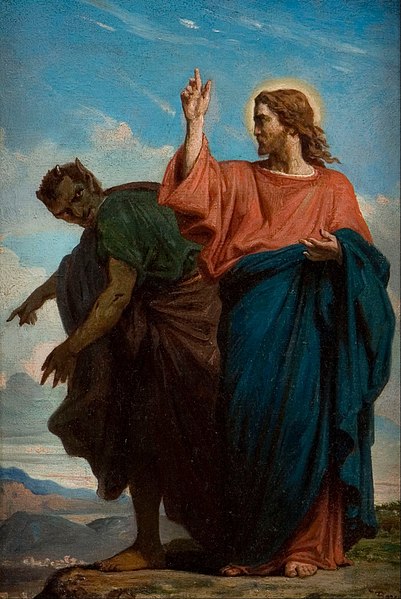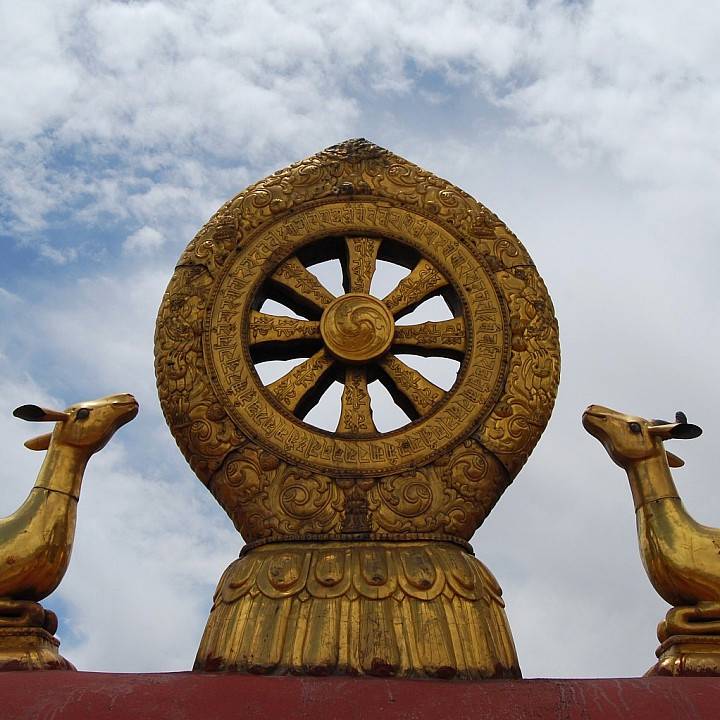For this week’s discussion, my group and I discussed Satan’s Temptation of Christ and the components that form the myth. We also discussed how other world religions have similar narratives in their mythology.
Background:

The Temptation of Christ is a narrative from the canonical gospels of Matthew, Mark, and Luke that tells the story of how Jesus was tempted by Satan for 40 days and night with only the wild animals and angels in his company. He fasted during the forty days so the Devil would come to Jesus and tell him to turn the stones on the ground into bread. Jesus refused this act of hedonism, telling Satan that man does not live off of bread but from the words of God. Satan would later take Jesus to the highest point of a holy city and tell Jesus to throw himself down. Satan would tempt him by Jesus by telling him that if he truly was the Son of God, the angels would break his fall. Jesus once again refused this act of egoism, telling the Devil not to put God, “…to the test”. The last temptation that Satan employed was offering Jesus all the kingdoms of the world in return for his worship and obedience. Jesus refused Satan’s last temptation which is an act of materialism and stated, “Worship the Lord your God, and serve him only.” Finally, the Devil left Jesus and the angels came and attended to Jesus. The Gospels specific to the temptation of Christ are Matthew 4:1-11, Luke 4:1-13, and Mark 1:12-13. The three temptations that Satan used were bread (hedonism), throw (egoism), kingdoms (materialism).
Landscape, Nature and Japanese Myths

After being baptized by John the Baptist, Jesus was led in the Judaean Desert by the Holy Spirit. The desert lies east of Jerusalem, a holy city in all Abrahamic religions. The desert is rugged, with many hills and has provided many a place of refuge who seek solitude and isolation such as Jesus Christ. The landscape and climate of the desert would prove to be difficult for Jesus Christ, where the region would have hot days and cold nights with very little humidity and rainfall. In such a difficult region, Jesus would be closer to God through the trials and tribulations against him in those 40 days.

The location of Jesus’ retreat is of significance just like locations of the myths in Japanese Mythology. The creation of the Japanese Islands is described in the myths involving Izanami and Izanagi. The tale describes how the two came together in union and gave birth to the Japanese archipelago and numerous important gods such as the sun goddess Amaterasu, the moon deity Tsukuyomi, and the wild storm god Susanoo.

Suffering, Salvation and Four Noble Truths in Buddhism
One of the key components in the Temptation of Christ is the notion of “suffering.” In the myth, Jesus “suffered” for 40 days as he battled his urges and temptations. In Genesis there is a passage by Job where he describes that there are two ways when faced with suffering, one can either curse God’s name or praise his name. In the Temptation of Christ, Jesus praised and defended God’s name in the face of evil, Satan. Finally, throughout the Bible, it is described that suffering brings forth glory and greater joy. It is described well in Corinthians 4:17-18 where he says that the “light momentary affliction is preparing for us an eternal weight of glory.” Jesus demonstrates this sentiment in the Temptation of Christ and it is a belief held by many Christians who face struggles. One of the most visible distinctions I can make from the Temptation of Christ and other biblical myths is the suffering is often the struggle to keep faith when faced with physical and mental hardship and anguish. One of the best depictions of suffering in media I have seen is the Martin Scorcese film, Silence. It tells the story of priests who suffer from faith when faced against the Japanese persecution and suppression of Christianity in Edo Era Japan.
Buddhism views suffering much in the same as Christianity, such that suffering is inevitable and the people must be equipped with dealing it. The Four Noble Truths of Buddhism revolve around the notion of suffering.
- Dukkha; suffering is innate characteristic of existence
- Samudaya; suffering is caused by desires or lust
- Nirodha; suffering ceases when renouncing desires
- Magga; liberation is through the Noble Eightfold Path or nirvana
The religions differ on how to face suffering. Christians try to achieve salvation from suffering by following God and his commandments. The first sin appeared when Adam and Eve first betrayed God and ate from the forbidden fruit. Since then, every person has been born with sin. Christians view suffering as a direct consequence of sin and to be free of suffering is to be free of sin and enter into heaven. This is different from Buddhism’s view on how to handle suffering because Buddhists don’t believe in deities, therefore, they can not seek salvation in a higher power. Instead, they must follow the Noble Eightfold Path to exit the cycle of reincarnation which is present in samsara.

Hedonism and Islam
During the 40 days and nights of Christ’s tribulations, he fasted during his spiritual battle. In Islam, another Abrahamic religion, fasting during Ramadan, the ninth month of the Islamic Calendar, is one of the five pillars and is means for spiritual reflection, improvement, cleansing, and heightened devotion and worship to Allah. Unlike Christianity views on sin, Muslims believe that all humans are born without sin and that through the act of prayers and forgiveness, Allah will forgive acts of sin committed. During the month of Ramadan, Muslims combat hedonism by refraining from not only food and drink but from other self-indulgent activities such as taking drugs and committing sexual relations and sinful speech. In the Quran 11:15-16, those who take part in hedonistic activities will be properly compensated with the fires of Hell. Muslims view hedonism is a behavior that can be completely avoided or at the very least limited to and forgiven through prayer and following the five pillars.

Hedonism in a non-religious definition is to pursue pleasure or self-indulgence. Hedonistic philosophy is to always act in the good of the individual through pleasure. There is a theologist, John Piper, that argues for Christian Hedonism which is to “glorify God by enjoying Him forever.” Fundamentally this clashes with the philosophical definition of hedonism but I believe the rejection of classical hedonism was acted out by Jesus during his retreat in the Judaean Desert. He refused the temptation of creating bread from stones which would only satisfy his pleasures for the body. Instead, he refused, telling Satan that words of Gods are enough to live off of. This borrows into the ideology of Christian Hedonism where Jesus acted in God’s glory. Satan left and Jesus was left with the angels and with God’s glory.
Conclusion
The Temptation of Christ by Satan is a story of the struggle of faith through suffering. It captures Jesus’ rejections of egoism, hedonism, and materialism. Buddhism is one religion that shares many similarities with Christianity on the inevitability of suffering and offers many opposing viewpoints on how to free oneself from the cycle of suffering. To combat hedonism and pleasures, Muslims fast every Ramadan and is an action taken by Christ during retreat in the Judaean Desert. The use of landscape and location is an important aspect in many world religions and myths and Japanese mythology provides some parallels for its use of nature in its narratives.
References:
New International Version. Biblica, 2020. Biblica.com
www.biblica.com/bible/
Quran. Quran, 2020. Quran.com
quran.com/?local=en
“BBC – Religions – Buddhism: The Four Noble Truths.” BBC, 2009, www.bbc.co.uk/religion/religions/buddhism/beliefs/fournobletruths_1.shtml.
Littlefair, Sam. “What Is Suffering?” Lions Roar, 2020, www.lionsroar.com/what-is-suffering-10-buddhist-teachers-weigh-in.
Cartwright, Mark. “Izanami and Izanagi.” Ancient History Encyclopedia, 2012, www.ancient.eu/Izanami_and_Izanagi.
Piper, John. Desiring God, Revised Edition: Meditations of a Christian Hedonist. Revised, Expanded, Multnomah, 2011.
Hamid, Rose. “Understanding God: How Muslims Look at the Story of Adam and Eve.” The Charlotte Observer [Charlotte, North Carolina], 2017, www.charlotteobserver.com/living/religion/article124740379.html.
Leave a Reply
You must be logged in to post a comment.